Lincoln Electric SVM103-C User Manual
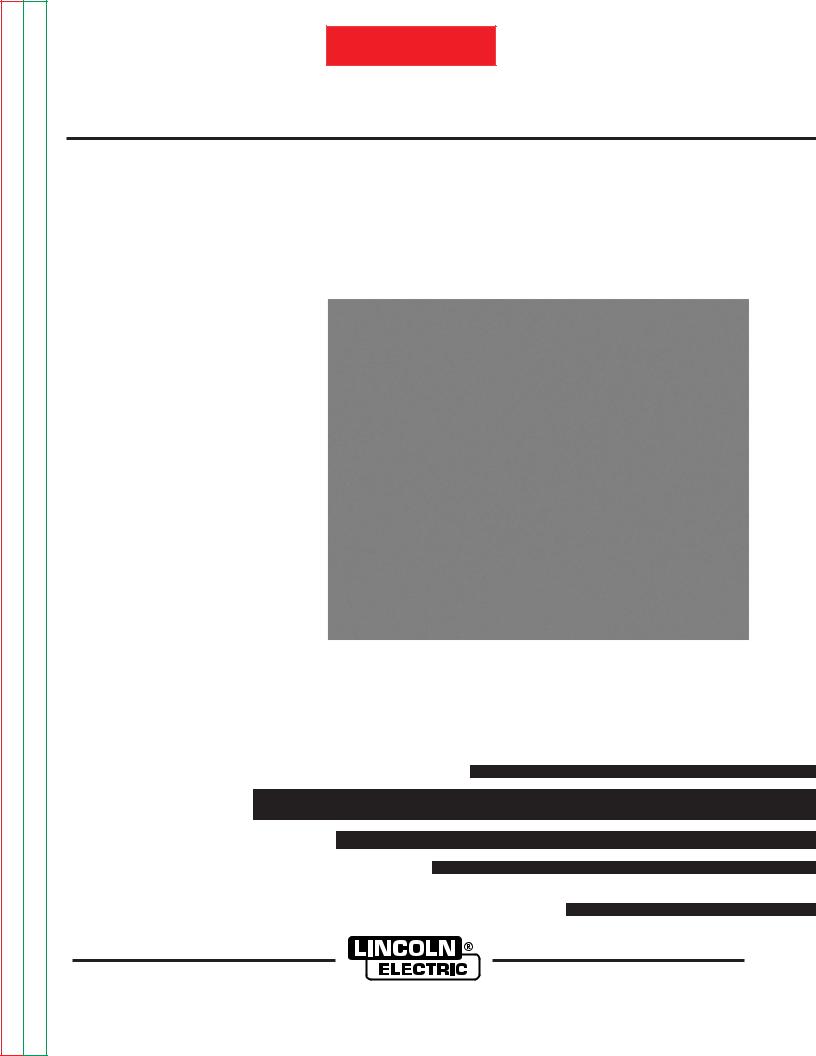
Return to Master TOC |
View Safety Info |
Return to Master TOC |
View Safety Info |
Return to Master TOC |
View Safety Info |
Return to Master TOC |
View Safety Info |
RETURN TO MAIN INDEX
SVM103-C
April, 2002
POWER-ARC ™ 4000
For Machines with Code Numbers: 10200 |
10585 |
10673 |
10202 10667 10792
10243 10671 10793
10244 10672 10866
For Machines with code Number 10083 Refer to SVM103-A (on Service Navigator CD)
Safety Depends on You
Lincoln arc welding and cutting equipment is designed and built with safety in mind. However, your overall safety can be increased by proper installation ... and thoughtful operation on your part. DO NOT INSTALL, OPERATE OR REPAIR THIS EQUIPMENT WITHOUT READING THIS MANUAL AND THE SAFETY PRECAUTIONS CONTAINED THROUGHOUT. And, most importantly, think before you act and be careful.
Various engine configurations are available and machine appearance will vary accordingly.
SERVICE MANUAL
Copyright © 2002 Lincoln Global Inc.
•World's Leader in Welding and Cutting Products •
•Sales and Service through Subsidiaries and Distributors Worldwide •
Cleveland, Ohio 44117-1199 U.S.A. TEL: 216.481.8100 FAX: 216.486.1751 WEB SITE: www.lincolnelectric.com
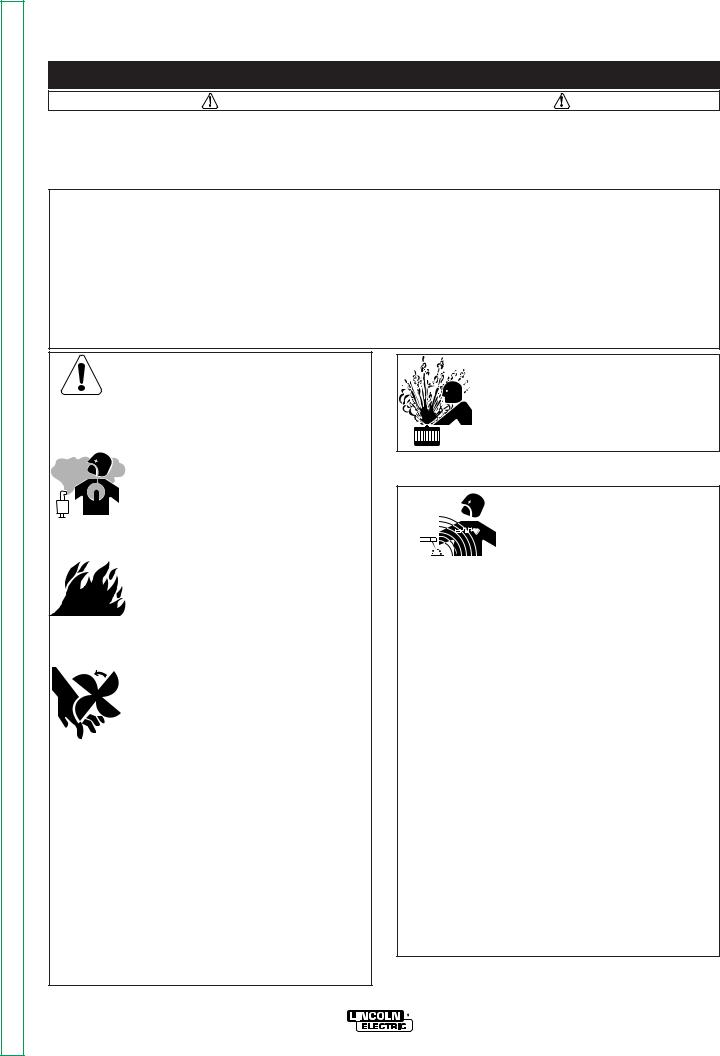
Return to Master TOC
Return to Master TOC
Return to Master TOC
Return to Master TOC
i |
|
SAFETY |
|
i |
|
|
|
|
|
|
|
|
|
|
 WARNING
WARNING
CALIFORNIA PROPOSITION 65 WARNINGS
Diesel engine exhaust and some of its constituents |
|
The engine exhaust from this product contains |
are known to the State of California to cause can- |
|
chemicals known to the State of California to cause |
cer, birth defects, and other reproductive harm. |
|
cancer, birth defects, or other reproductive harm. |
|
|
|
The Above For Diesel Engines |
|
The Above For Gasoline Engines |
ARC WELDING CAN BE HAZARDOUS. PROTECT YOURSELF AND OTHERS FROM POSSIBLE SERIOUS INJURY OR DEATH. KEEP CHILDREN AWAY. PACEMAKER WEARERS SHOULD CONSULT WITH THEIR DOCTOR BEFORE OPERATING.
Read and understand the following safety highlights. For additional safety information, it is strongly recommended that you purchase a copy of “Safety in Welding & Cutting - ANSI Standard Z49.1” from the American Welding Society, P.O. Box 351040, Miami, Florida 33135 or CSA Standard W117.2-1974. A Free copy of “Arc Welding Safety” booklet E205 is available from the Lincoln Electric Company, 22801 St. Clair Avenue, Cleveland, Ohio 44117-1199.
BE SURE THAT ALL INSTALLATION, OPERATION, MAINTENANCE AND REPAIR PROCEDURES ARE PERFORMED ONLY BY QUALIFIED INDIVIDUALS.
FOR ENGINE powered equipment.
1.a. Turn the engine off before troubleshooting and maintenance work unless the maintenance work requires it to be running.
____________________________________________________
1.b.Operate engines in open, well-ventilated areas or vent the engine exhaust fumes
outdoors.
____________________________________________________
1.c. Do not add the fuel near an open flame welding arc or when the engine is running.
Stop the engine and allow it to cool before refueling to prevent spilled fuel from vaporizing on contact with hot engine parts and igniting. Do not spill fuel when filling tank. If fuel is spilled, wipe it up and do not start engine until fumes have been eliminated.
____________________________________________________
1.d. Keep all equipment safety guards, covers and devices in position and in good repair.Keep hands, hair, clothing and tools away from V-belts, gears, fans and all other moving parts when starting, operating or
repairing equipment.
____________________________________________________
1.e. In some cases it may be necessary to remove safety guards to perform required maintenance. Remove guards only when necessary and replace them when the maintenance requiring their removal is complete. Always use the greatest care when working near moving parts.
___________________________________________________
1.f. Do not put your hands near the engine fan. Do not attempt to override the governor or idler by pushing on the throttle control rods while the engine is running.
___________________________________________________
1.g. To prevent accidentally starting gasoline engines while turning the engine or welding generator during maintenance work, disconnect the spark plug wires, distributor cap or magneto wire as appropriate.
1.h. To avoid scalding, do not remove the radiator pressure cap when the engine is hot.
ELECTRIC AND MAGNETIC FIELDS may be dangerous
2.a. Electric current flowing through any conductor causes localized Electric and Magnetic Fields (EMF). Welding current creates EMF fields around welding cables and welding machines
2.b. EMF fields may interfere with some pacemakers, and welders having a pacemaker should consult their physician before welding.
2.c. Exposure to EMF fields in welding may have other health effects which are now not known.
2.d. All welders should use the following procedures in order to minimize exposure to EMF fields from the welding circuit:
2.d.1. Route the electrode and work cables together - Secure them with tape when possible.
2.d.2. Never coil the electrode lead around your body.
2.d.3. Do not place your body between the electrode and work cables. If the electrode cable is on your right side, the work cable should also be on your right side.
2.d.4. Connect the work cable to the workpiece as close as possible to the area being welded.
2.d.5. Do not work next to welding power source.
Mar ‘95
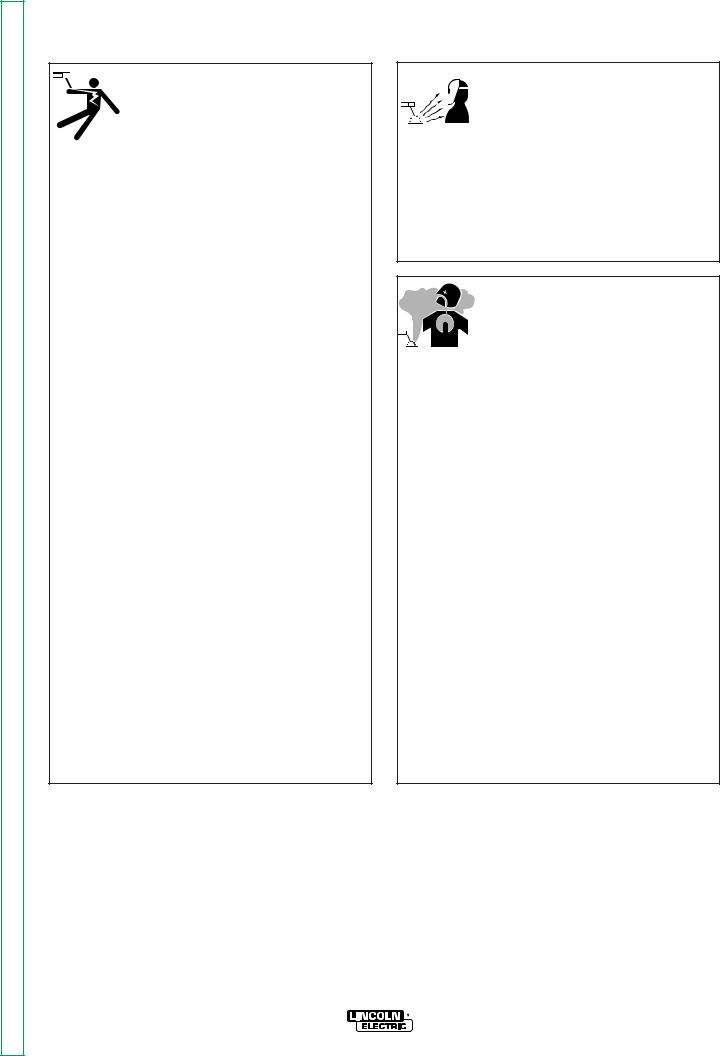
Return to Master TOC
Return to Master TOC
Return to Master TOC
Return to Master TOC
ii |
|
SAFETY |
|
ii |
|
|
|
|
|
|
|
|
|
|
ELECTRIC SHOCK can
kill.
3.a. The electrode and work (or ground) circuits are electrically “hot” when the welder is on. Do not touch these “hot” parts with your bare skin or wet clothing. Wear dry, hole-free
gloves to insulate hands.
3.b. Insulate yourself from work and ground using dry insulation. Make certain the insulation is large enough to cover your full area of physical contact with work and ground.
In addition to the normal safety precautions, if welding must be performed under electrically hazardous conditions (in damp locations or while wearing wet clothing; on metal structures such as floors, gratings or scaffolds; when in cramped positions such as sitting, kneeling or lying, if there is a high risk of unavoidable or accidental contact with the workpiece or ground) use the following equipment:
•Semiautomatic DC Constant Voltage (Wire) Welder.
•DC Manual (Stick) Welder.
•AC Welder with Reduced Voltage Control.
3.c. In semiautomatic or automatic wire welding, the electrode, electrode reel, welding head, nozzle or semiautomatic welding gun are also electrically “hot”.
3.d. Always be sure the work cable makes a good electrical connection with the metal being welded. The connection should be as close as possible to the area being welded.
3.e. Ground the work or metal to be welded to a good electrical (earth) ground.
3.f. Maintain the electrode holder, work clamp, welding cable and welding machine in good, safe operating condition. Replace damaged insulation.
3.g. Never dip the electrode in water for cooling.
3.h. Never simultaneously touch electrically “hot” parts of electrode holders connected to two welders because voltage between the two can be the total of the open circuit voltage of both welders.
3.i. When working above floor level, use a safety belt to protect yourself from a fall should you get a shock.
3.j. Also see Items 6.c. and 8.
ARC RAYS can burn.
4.a. Use a shield with the proper filter and cover plates to protect your eyes from sparks and the rays of the arc when welding or observing open arc welding. Headshield and filter lens should conform to ANSI Z87. I standards.
4.b. Use suitable clothing made from durable flame-resistant material to protect your skin and that of your helpers from the arc rays.
4.c. Protect other nearby personnel with suitable, non-flammable screening and/or warn them not to watch the arc nor expose themselves to the arc rays or to hot spatter or metal.
FUMES AND GASES
can be dangerous.
5.a. Welding may produce fumes and gases
hazardous to health. Avoid breathing these fumes and gases.When welding, keep your head out of the fume. Use enough ventilation and/or exhaust at the arc to keep
fumes and gases away from the breathing zone. When welding with electrodes which require special ventilation such as stainless or hard facing (see instructions on container or MSDS) or on lead or cadmium plated steel and other metals or coatings which produce highly toxic fumes, keep exposure as low as possible and below Threshold Limit Values (TLV) using local exhaust or mechanical ventilation. In confined spaces or in some circumstances, outdoors, a respirator may be required. Additional precautions are also required when welding on galvanized steel.
5.b. Do not weld in locations near chlorinated hydrocarbon vapors coming from degreasing, cleaning or spraying operations.
The heat and rays of the arc can react with solvent vapors to form phosgene, a highly toxic gas, and other irritating products.
5.c. Shielding gases used for arc welding can displace air and cause injury or death. Always use enough ventilation, especially in confined areas, to insure breathing air is safe.
5.d. Read and understand the manufacturer’s instructions for this equipment and the consumables to be used, including the material safety data sheet (MSDS) and follow your employer’s safety practices. MSDS forms are available from your welding distributor or from the manufacturer.
5.e. Also see item 1.b. |
Mar ‘95 |
|

Return to Master TOC
Return to Master TOC
Return to Master TOC
Return to Master TOC
iii |
|
SAFETY |
|
iii |
|
|
|
|
 WELDING SPARKS can
WELDING SPARKS can

 cause fire or explosion.
cause fire or explosion.
6.a. Remove fire hazards from the welding area. If this is not possible, cover them to prevent the welding sparks from starting a fire.
Remember that welding sparks and hot materials from welding can easily go through small cracks and openings to adjacent areas. Avoid welding near hydraulic lines. Have a fire extinguisher readily available.
6.b. Where compressed gases are to be used at the job site, special precautions should be used to prevent hazardous situations. Refer to “Safety in Welding and Cutting” (ANSI Standard Z49.1) and the operating information for the equipment being used.
6.c. When not welding, make certain no part of the electrode circuit is touching the work or ground. Accidental contact can cause overheating and create a fire hazard.
6.d. Do not heat, cut or weld tanks, drums or containers until the proper steps have been taken to insure that such procedures will not cause flammable or toxic vapors from substances inside. They can cause an explosion even though they have been “cleaned”. For information, purchase “Recommended Safe Practices for the Preparation for Welding and Cutting of
Containers and Piping That Have Held Hazardous Substances”, AWS F4.1 from the American Welding Society
(see address above).
6.e. Vent hollow castings or containers before heating, cutting or welding. They may explode.
6.f. Sparks and spatter are thrown from the welding arc. Wear oil free protective garments such as leather gloves, heavy shirt, cuffless trousers, high shoes and a cap over your hair. Wear ear plugs when welding out of position or in confined places. Always wear safety glasses with side shields when in a welding area.
6.g. Connect the work cable to the work as close to the welding area as practical. Work cables connected to the building framework or other locations away from the welding area increase the possibility of the welding current passing through lifting chains, crane cables or other alternate circuits. This can create fire hazards or overheat lifting chains or cables until they fail.
6.h. Also see item 1.c.
CYLINDER may explode






 if damaged.
if damaged.
7.a. Use only compressed gas cylinders
containing the correct shielding gas for the process used and properly operating regulators designed for the gas and
pressure used. All hoses, fittings, etc. should be suitable for the application and maintained in good condition.
7.b. Always keep cylinders in an upright position securely chained to an undercarriage or fixed support.
7.c. Cylinders should be located:
•Away from areas where they may be struck or subjected to physical damage.
•A safe distance from arc welding or cutting operations and any other source of heat, sparks, or flame.
7.d. Never allow the electrode, electrode holder or any other electrically “hot” parts to touch a cylinder.
7.e. Keep your head and face away from the cylinder valve outlet when opening the cylinder valve.
7.f. Valve protection caps should always be in place and hand tight except when the cylinder is in use or connected for use.
7.g. Read and follow the instructions on compressed gas cylinders, associated equipment, and CGA publication P-l,
“Precautions for Safe Handling of Compressed Gases in Cylinders,” available from the Compressed Gas Association 1235 Jefferson Davis Highway, Arlington, VA 22202.
FOR ELECTRICALLY powered equipment.
8.a. Turn off input power using the disconnect switch at the fuse box before working on the equipment.
8.b. Install equipment in accordance with the U.S. National Electrical Code, all local codes and the manufacturer’s recommendations.
8.c. Ground the equipment in accordance with the U.S. National Electrical Code and the manufacturer’s recommendations.
Mar ‘95

Return to Master TOC
Return to Master TOC
Return to Master TOC
Return to Master TOC
iv |
SAFETY |
iv |
|
|
|
|
|
|
PRÉCAUTIONS DE SÛRETÉ
Pour votre propre protection lire et observer toutes les instructions et les précautions de sûreté specifiques qui parraissent dans ce manuel aussi bien que les précautions de sûreté générales suivantes:
Sûreté Pour Soudage A L’Arc
1.Protegez-vous contre la secousse électrique:
a.Les circuits à l’électrode et à la piéce sont sous tension quand la machine à souder est en marche. Eviter toujours tout contact entre les parties sous tension et la peau nue ou les vétements mouillés. Porter des gants secs et sans trous pour isoler les mains.
b.Faire trés attention de bien s’isoler de la masse quand on soude dans des endroits humides, ou sur un plancher metallique ou des grilles metalliques, principalement dans les positions assis ou couché pour lesquelles une grande partie du corps peut être en contact avec la
masse.
c.Maintenir le porte-électrode, la pince de masse, le câble de soudage et la machine à souder en bon et sûr état
defonctionnement.
d.Ne jamais plonger le porte-électrode dans l’eau pour le refroidir.
e.Ne jamais toucher simultanément les parties sous tension des porte-électrodes connectés à deux machines à souder parce que la tension entre les deux pinces peut être le total de la tension à vide des deux machines.
f.Si on utilise la machine à souder comme une source de courant pour soudage semi-automatique, ces precautions pour le porte-électrode s’applicuent aussi au pistolet de soudage.
2.Dans le cas de travail au dessus du niveau du sol, se protéger contre les chutes dans le cas ou on recoit un choc. Ne jamais enrouler le câble-électrode autour de n’importe quelle partie du corps.
3.Un coup d’arc peut être plus sévère qu’un coup de soliel, donc:
a.Utiliser un bon masque avec un verre filtrant approprié ainsi qu’un verre blanc afin de se protéger les yeux du rayonnement de l’arc et des projections quand on soude ou quand on regarde l’arc.
b.Porter des vêtements convenables afin de protéger la peau de soudeur et des aides contre le rayonnement de l‘arc.
c.Protéger l’autre personnel travaillant à proximité au soudage à l’aide d’écrans appropriés et non-inflamma- bles.
4.Des gouttes de laitier en fusion sont émises de l’arc de soudage. Se protéger avec des vêtements de protection libres de l’huile, tels que les gants en cuir, chemise épaisse, pantalons sans revers, et chaussures montantes.
5.Toujours porter des lunettes de sécurité dans la zone de soudage. Utiliser des lunettes avec écrans lateraux dans les zones où l’on pique le laitier.
6.Eloigner les matériaux inflammables ou les recouvrir afin de prévenir tout risque d’incendie dû aux étincelles.
7.Quand on ne soude pas, poser la pince à une endroit isolé de la masse. Un court-circuit accidental peut provoquer un
échauffement et un risque d’incendie.
8.S’assurer que la masse est connectée le plus prés possible de la zone de travail qu’il est pratique de le faire. Si on place la masse sur la charpente de la construction ou d’autres endroits éloignés de la zone de travail, on augmente le risque de voir passer le courant de soudage par les chaines de levage, câbles de grue, ou autres circuits. Cela peut provoquer des risques d’incendie ou d’echauffement des chaines et des câbles jusqu’à ce qu’ils se rompent.
9.Assurer une ventilation suffisante dans la zone de soudage. Ceci est particuliérement important pour le soudage de tôles galvanisées plombées, ou cadmiées ou tout autre métal qui produit des fumeés toxiques.
10.Ne pas souder en présence de vapeurs de chlore provenant d’opérations de dégraissage, nettoyage ou pistolage. La chaleur ou les rayons de l’arc peuvent réagir avec les vapeurs du solvant pour produire du phosgéne (gas fortement toxique) ou autres produits irritants.
11.Pour obtenir de plus amples renseignements sur la sûreté, voir le code “Code for safety in welding and cutting” CSA Standard W 117.2-1974.
PRÉCAUTIONS DE SÛRETÉ POUR LES MACHINES À SOUDER À TRANSFORMATEUR ET À REDRESSEUR
1.Relier à la terre le chassis du poste conformement au code de l’électricité et aux recommendations du fabricant. Le dispositif de montage ou la piece à souder doit être branché à une bonne mise à la terre.
2.Autant que possible, I’installation et l’entretien du poste seront effectués par un électricien qualifié.
3.Avant de faires des travaux à l’interieur de poste, la debrancher à l’interrupteur à la boite de fusibles.
4.Garder tous les couvercles et dispositifs de sûreté à leur place.
Mar. ‘93

vi |
|
vi |
RETURN TO MAIN INDEX
MASTER TABLE OF CONTENTS FOR ALL SECTIONS
|
Page |
Safety................................................................................................................................................. |
i-iv |
|
|
Installation ............................................................................................................................. |
Section A |
Technical Specifications ............................................................................................................. |
A-2 |
Safety Precautions...................................................................................................................... |
A-3 |
Location and Ventilation ............................................................................................................. |
A-3 |
Pre-operation Engine Service ..................................................................................................... |
A-4 |
Electrical Output Connections .................................................................................................... |
A-6 |
|
|
Operation............................................................................................................................... |
Section B |
Safety Instructions ...................................................................................................................... |
B-2 |
General Description .................................................................................................................... |
B-2 |
Recommended Applications....................................................................................................... |
B-3 |
Operational Features and Controls............................................................................................. |
B-3 |
Design Features and Advantages............................................................................................... |
B-3 |
Welding Capability ...................................................................................................................... |
B-3 |
Limitations ................................................................................................................................. |
B-3 |
Controls and Settings ................................................................................................................. |
B-4 |
Engine Operation ........................................................................................................................ |
B-6 |
Generator Operation ................................................................................................................... |
B-8 |
Welding Operation .................................................................................................................... |
B-10 |
Welding Guidelines ................................................................................................................... |
B-11 |
|
|
Accessories........................................................................................................................... |
Section C |
|
|
Maintenance.......................................................................................................................... |
Section D |
Safety Precautions...................................................................................................................... |
D-2 |
Routine and Periodic Maintenance............................................................................................. |
D-2 |
Major Component Locations ...................................................................................................... |
D-6 |
|
|
Theory of Operation.............................................................................................................. |
Section E |
|
|
Troubleshooting and Repair ................................................................................................ |
Section F |
|
|
Electrical Diagrams .............................................................................................................. |
Section G |
|
|
Parts List ......................................................................................................................... |
P233 or P352 |
POWER-ARC 4000

Return to Master TOC
Return to Master TOC
Return to Master TOC
Return to Master TOC
Section A |
Section A |
TABLE OF CONTENTS
- INSTALLATION SECTION -
|
Page |
Installation ............................................................................................................................. |
Section A |
Technical Specifications ............................................................................................................. |
A-2 |
Safety Precautions...................................................................................................................... |
A-3 |
Location and Ventilation ............................................................................................................. |
A-3 |
Storing ................................................................................................................................. |
A-3 |
Stacking................................................................................................................................ |
A-4 |
Tilting ................................................................................................................................. |
A-4 |
Lifting ................................................................................................................................. |
A-4 |
Pre-operation Engine Service ..................................................................................................... |
A-4 |
Oil ................................................................................................................................. |
A-4 |
Fuel ................................................................................................................................. |
A-4 |
Muffler Defelector ................................................................................................................. |
A-4 |
Spark Arrester....................................................................................................................... |
A-5 |
Electrical Output Connections .................................................................................................... |
A-6 |
Welding Cable Connections ................................................................................................. |
A-6 |
Cable Size and Length ................................................................................................... |
A-6 |
Cable Installation............................................................................................................ |
A-7 |
Machine Grounding .............................................................................................................. |
A-7 |
Plugs and Hand-Held Equipment......................................................................................... |
A-7 |
Auxiliary Power Receptacles ................................................................................................ |
A-7 |
Premises Wiring.................................................................................................................... |
A-8 |
Circuit Breakers .................................................................................................................... |
A-8 |
POWER-ARC 4000

Return to Section TOC |
Return to Master TOC |
Return to Section TOC |
Return to Master TOC |
Return to Section TOC |
Return to Master TOC |
Return to Section TOC |
Return to Master TOC |
A-2 |
INSTALLATION |
A-2 |
|
|
|
TECHNICAL SPECIFICATIONS - POWER-ARC 4000
INPUT - BRIGGS KOOL-BORE® GASOLINE ENGINE
Manufacturer |
Description |
Speed |
Displacement |
Ignition |
Capacities |
|
Briggs & |
1 cyl., |
3700 |
RPM |
19.4 cu. in. |
Manual, |
Fuel: 1.0 gal. (3.8 l) |
Stratton Kool- |
4 cycle |
± 50 |
RPM |
(319 cc) |
Recoil |
|
Bore® Plus |
air-cooled |
at no load |
|
start; Manual |
Oil: 1.4 qt. (1.3 l) |
|
|
gasoline |
|
|
|
choke |
|
|
8 HP @ |
|
|
|
|
|
|
3750 RPM |
|
|
|
|
|
|
INPUT - BRIGGS VANGUARD® GASOLINE ENGINE |
||||
Briggs & |
1 cyl., |
3700 RPM |
18.06 cu. in. |
Manual, |
Fuel: 1.6 gal. (6.0 l) |
Stratton |
4 cycle |
+ 50 RPM |
(296 cc) |
Recoil |
|
Vanguard® |
air-cooled OHV |
at no load |
|
start; Manual |
Oil 1.25 qt. (1.2 l) |
Model 185432 |
gasoline |
|
|
Choke |
|
|
9 HP @ |
|
|
|
|
|
3750 RPM |
|
|
|
|
|
|
INPUT - BRIGGS INTEK® GASOLINE ENGINE |
|
|
||||||
|
Briggs & |
1 cyl., |
3700 RPM |
|
18.64 cu. in. |
Manual, |
Fuel: 1.0 gal. (3.8 l) |
|
||
|
Stratton Intek® |
4 cycle |
+ 50 RPM |
|
(305 cc) |
Recoil |
|
|
||
|
Model |
air-cooled |
at no load |
|
|
start; Manual |
Oil 28 oz. (0.8 l) |
|
||
|
|
OHV gasoline |
|
|
|
Choke |
|
|
||
|
|
8 HP @ |
|
|
|
|
|
|
|
|
|
|
3750 RPM |
|
|
|
|
|
|
|
|
|
|
|
|
|
|
|
|
|
|
|
|
|
|
INPUT - HONDA GASOLINE ENGINE |
|
|
|||||
|
Honda |
1 cyl., |
3700 RPM |
|
16.5 cu. in. |
Manual, |
Fuel: 1.59 gal. (3.8 l) |
|
||
|
GX 270 VA2 |
4 cycle |
+ 50 RPM |
|
(270 cc) |
Recoil |
|
|
||
|
|
air-cooled |
at no load |
|
|
start; Manual |
Oil 1.16 qt. (1.11 l) |
|
||
|
|
OHV gasoline |
|
|
|
Choke |
|
|
||
|
|
9 HP @ |
|
|
|
|
|
|
|
|
|
|
3750 RPM |
|
|
|
|
|
|
|
|
|
|
|
|
|
|
|
|
|
|
|
|
|
|
|
RATED OUTPUT - WELDER |
|
|
|
|
||
|
Duty Cycle |
|
Amps |
Volts at Rated Amperes |
|
|||||
|
30% Duty Cycle |
|
125 |
|
|
20 VAC |
|
|||
|
60% Duty Cycle |
|
100 |
|
|
25 VAC |
|
|||
|
|
|
|
|
|
|
|
|
|
|
|
|
|
OUTPUT - WELDER AND GENERATOR |
|
|
|||||
|
Welding Ranges |
Welder Open Circuit |
AC Auxiliary Power |
|
||||||
|
70 - 125 Amps |
|
Voltage |
4000 Continuous Watts |
|
|||||
|
|
|
|
|
||||||
|
|
|
|
62 VAC Max. |
|
4400 Surge Watts |
|
|||
|
|
|
|
|
|
|
|
|
|
|
|
|
|
|
PHYSICAL |
DIMENSIONS |
|
|
|
|
|
|
Height |
|
|
Width |
|
Depth |
|
|
Weight |
|
|
20.9 in. |
|
|
20 in. |
|
30 in. |
|
|
160 lb. |
|
|
530 mm |
|
|
508 mm |
|
762 mm |
|
|
72.5 kg |
|
|
|
|
|
|
|
|
|
|
|
|
POWER-ARC 4000

Return to Section TOC |
Return to Master TOC |
Return to Section TOC |
Return to Master TOC |
Return to Section TOC |
Return to Master TOC |
Return to Section TOC |
Return to Master TOC |
A-3 |
INSTALLATION |
A-3 |
|
|
|
Read this entire installation section before you start installation.
SAFETY PRECAUTIONS
WARNING
Do not attempt to use this equipment until you have thoroughly read all the operation and maintenance manuals supplied with your machine. They include important safety precautions; detailed engine starting, operating, and maintenance instructions; and parts lists.
ELECTRIC SHOCK can kill.
•Do not touch electrically live parts or electrodes with your skin or wet clothing.
•Insulate yourself from the work and ground.
•Always wear dry insulating gloves.
ENGINE EXHAUST can kill.
•Use in open, well ventilated areas or vent exhaust to the outside.
•Do not stack anything on or near the engine.
MOVING PARTS can injure.
•Do not operate this equipment with any of its doors open or guards off.
•Stop the engine before servicing it.
•Keep away from moving parts.
Only qualified personnel should install, use, or service this equipment.
LOCATION AND VENTILATION
Whenever you use the POWER-ARC 4000, be sure that clean cooling air can flow through the machine’s gasoline engine and the generator. Avoid dusty, dirty areas. Also, keep the machine away from heat sources. Do not place the back end of the generator anywhere near hot engine exhaust from another machine. And of course, make sure that engine exhaust is ventilated to an open, outside area.
The POWER-ARC 4000 may be used outdoors. Do not set the machine in puddles or otherwise submerge it in water. Such practices pose safety hazards and cause improper operation and corrosion of parts.
Always operate the POWER-ARC 4000 with the case roof on and all machine components completely assembled. This will protect you from the dangers of moving parts, hot metal surfaces, and live electrical devices.
STORING
1.Store the machine in a cool, dry place when it’s not in use. Protect it from dust and dirt. Keep it where it can’t be accidentally damaged from construction activities, moving vehicles, and other hazards.
2.If you will be storing the machine for over 30 days, you should drain the fuel to protect fuel system and carburetor parts from gum deposits. Empty all fuel from the tank and run the engine until it stops from lack of fuel.
3.You can store the machine for up to 24 months if you use Briggs & Stratton Gasoline Additive, Part No. 5041 (available from any Authorized Briggs & Stratton Service Center), in the fuel system. Mix the additive with the fuel in the tank and run the engine for a short time to circulate the additive through the carburetor.
4.While the engine is still warm, drain the oil and refill with fresh oil per the engine manual.
5.Remove the spark plug and pour approximately 1/2 ounce (15 ml) of engine oil into the cylinder. Replace the spark plug and crank the engine slowly to distribute the oil.
6.Clean any dirt and debris from the cylinder and cylinder head fins and housing, rotating screen, and muffler areas.
7.Store in a clean, dry area.
POWER-ARC 4000

Return to Section TOC |
Return to Master TOC |
Return to Section TOC |
Return to Master TOC |
Return to Section TOC |
Return to Master TOC |
Return to Section TOC |
Return to Master TOC |
A-4 |
INSTALLATION |
A-4 |
|
|
|
STACKING
POWER-ARC 4000 machines CANNOT be stacked.
TILTING
Place the machine on a secure, level surface whenever you use it or store it. Any surfaces you place it on other than the ground must be firm, non-skid, and structurally sound.
The gasoline engine is designed to run in a level position for best performance. It can operate at an angle, but this should never be more than 15 degrees in any direction. If you do operate it at a slight angle, be sure to check the oil regularly and keep the oil level full. Also, fuel capacity will be a little less at an angle.
LIFTING
The POWER-ARC 4000 should be lifted by two people. (It weighs 160 lbs/72.5 kg.) Its welded tube roll cage is designed to make lifting easy.
OIL
The Power-Arc 4000 with the Briggs and 
 Stratton 8 HP engine and the Power-Arc
Stratton 8 HP engine and the Power-Arc
4000 with the Honda 9 HP engine are supplied with low oil protection. The Power-Arc 4000 with the Briggs and Stratton 8 HP engine is equipped with protection that will prevent the engine from starting if the oil level is low. The Power-Arc 4000 with the Honda 9 HP engine is equipped with protection that will shut down the engine in the event of a low oil condition. The engine cannot be restarted until sufficient oil is added.
The POWER-ARC 4000 is shipped with the engine filled with SAE 10W-30 oil. CHECK THE OIL LEVEL BEFORE YOU START THE ENGINE. This is an added precaution. When full, the oil level should be at the top of the fill plug hole. If it is not full, add enough oil to fill it. Be sure the fill plug is tight. Change oil after the first 5 hours of operation.
For more oil fill and service information, see the Briggs & Stratton Engine manual.
ANGLE OF OPERATION
Internal combustion engines are designed to run in a level condition to achieve optimum performance. The maximum angle of operation for the engine 15 degrees from horizontal in any direction. Be certain to place the machine on a firm, non-skid, structural supporting surface. Anchor unit if necessary.
If you are operating the engine at a slight angle, be certain to check the oil regularly and maintain a level, full oil condition. The effective fuel capacity will also be slightly less than the specified 1.00 gallon (3.8
liters).
PRE-OPERATION ENGINE SERVICE
Read and understand the information about the gasoline engine in the OPERATION and MAINTENANCE sections of this manual before you operate the POWER-ARC 4000.
WARNING
•Keep hands away from the engine muffler or HOT engine parts.
•Stop the engine when fueling.
•Do not smoke when fueling.
•Remove the fuel cap slowly to release pressure.
•Do not overfill the fuel tank.
•Wipe up spilled fuel and allow the fumes to clear before starting the engine.
•Keep sparks and flame away from the fuel tank.
FUEL
Fill the fuel tank with clean, fresh, regular grade leadfree gasoline. DO NOT MIX OIL WITH THE GASO-
LINE.
The POWER-ARC 4000 has a plastic, 1.0 gallon (3.8L) fuel tank mounted on the engine. See the Briggs & Stratton Engine manual for more details about fuel.
MUFFLER DEFLECTOR
The POWER-ARC 4000 is shipped with an exhaust deflector. You can mount it yourself on the gasoline engine.
To install the deflector, do the following:
•Align the holes on the deflector plate with the holes on the muffler.
•Position the deflector so that the opening points either right, left, or downward, away from the operator.
CAUTION
Never position the deflector upward. Moisture or debris can enter the engine and damage it. As a general safety practice, position the deflector to direct exhaust gases away from the operator’s face and eyes.
•Fasten the deflector onto the muffler with the screws provided.
NOTE: The deflector reduces generator output power up to 100 watts.
POWER-ARC 4000

Return to Section TOC |
Return to Master TOC |
Return to Section TOC |
Return to Master TOC |
Return to Section TOC |
Return to Master TOC |
Return to Section TOC |
Return to Master TOC |
A-5 |
|
INSTALLATION |
|
A-5 |
||
|
|
|
|
|
|
|
|
|
Power-Arc 4000 Typical Fuel Consumption |
|
|||
|
|
|
|
|
|
|
|
|
B&S 8 HP Carb. |
B&S 8 HP Carb. |
|
B&S 9 HP |
Honda 9 HP |
|
|
Certified Intek |
Cert. Kool Bore® |
|
Vanguard® |
Carb. Certified |
|
|
|
|
|
|
|
No Load |
.28 Gallons/Hour |
.36 Gallons/Hour |
|
.33 Gallons/Hour |
.30 Gallons/Hour |
|
3700 RPM + 50 R.P.M. |
(1.06 Liters/Hour) |
(1.37 Liters/Hour) |
|
(1.25 Liters/Hour) |
(1.14 Liters/Hour) |
|
|
|
|
|
|
|
|
AC CC Weld Output |
.57 Gallons/Hour |
.69 Gallons/Hour |
|
.76 Gallons/Hour |
.58 Gallons/Hour |
|
125 Amps @ 18 Volts |
(2.16 Liters/Hour) |
(2.63 Liters/Hour) |
|
(2.9 Liters/Hour) |
(2.18 Liters/Hour) |
|
|
|
|
|
|
|
|
AC CC Weld Output |
.52 Gallons/Hour |
.64 Gallons/Hour |
|
.63 Gallons/Hour |
.55 Gallons/Hour |
|
100 Amps @25 Volts |
(1.97 Liters/Hour) |
(2.41 Liters/Hour) |
|
(2.4 Liters/Hour) |
(2.1 Liters/Hour) |
|
|
|
|
|
|
|
|
Auxiliary Power 4000 |
.59 Gallons/Hour |
.77 Gallons/Hour |
|
.76 Gallons/Hour |
.67 Gallons/Hour |
|
Watts (120/240 Volts) |
(2.23 Liters/Hour) |
(2.92 Liters/Hour) |
|
(2.9 Liters/Hour) |
(2.54 Liters/Hour) |
|
|
|
|
|
|
|
|
SPARK ARRESTER
Gasoline engine mufflers may emit sparks when the engine is running. Some federal, state, or local laws require spark arresters in locations where unarrested sparks could present a fire hazard.
Standard mufflers and deflectors (like the ones included with the POWER-ARC 4000) do not act as spark arresters. When local laws require it, a spark arrester must be installed on the machine and properly maintained. An optional spark arrester kit is available for your POWER-ARC 4000. See the ACCESSORIES section of this manual for more information.
CAUTION
An incorrect spark arrester may lead to damage to the engine or reduce performance. A suitable spark arrester for the Briggs & Stratton 8 HP Cool Bore® engine is available as a Lincoln field-installed option.
POWER-ARC 4000
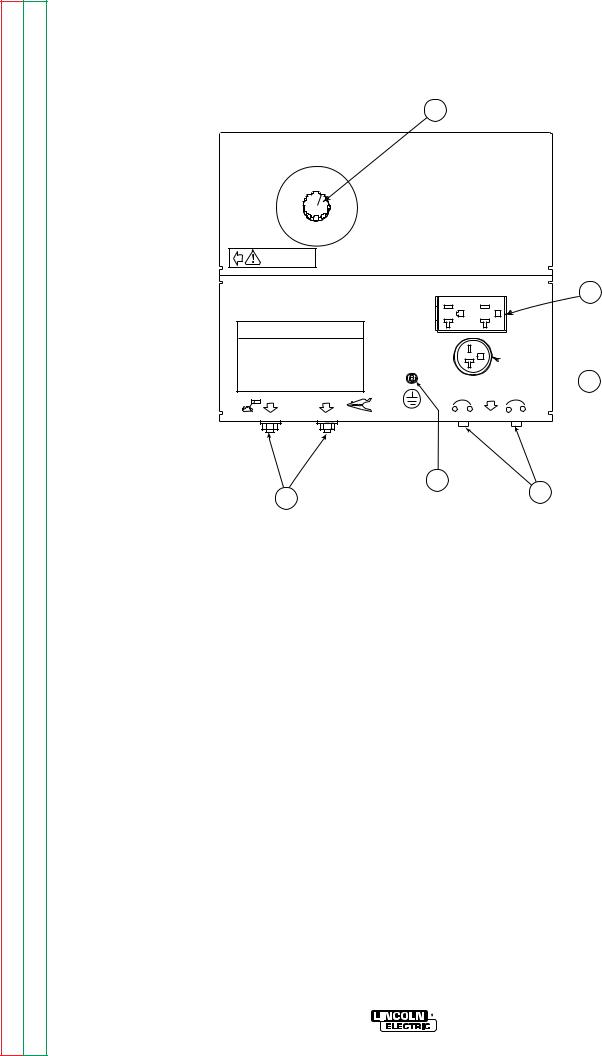
Return to Section TOC |
Return to Master TOC |
Return to Section TOC |
Return to Master TOC |
Return to Section TOC |
Return to Master TOC |
Return to Section TOC |
Return to Master TOC |
A-6 |
INSTALLATION |
A-6 |
|
|
|
FIGURE A.1 - POWER-ARC 4000 OUTPUT CONNECTIONS
1
POWER ARC 4000
70 |
80 |
AMPS |
|
AMPS |
|
125 |
90 |
AMPS |
|
GENERATOR |
AMPS |
100
AMPS
WARNING
6
ELECTRODE SELECTION GUIDE
 5
5
|
3 |
2 |
4 |
|
1. |
CURRENT CONTROL DIAL |
4. |
CIRCUIT BREAKERS (2) - 20 AMP |
|
2. |
WELD OUTPUT TERMINALS (2) |
5. |
RECEPTACLE - 240 VOLT, 20 AMP |
|
3. |
GROUND STUD |
6. |
DUPLEX RECEPTACLE - 120 |
VOLT, |
|
|
|
20 AMP |
|
ELECTRICAL OUTPUT
CONNECTIONS
See Figure A.1 for the location of the current control dial, weld output terminals, ground stud, circuit breakers, 240 and 120 volt receptacles.
TABLE A.1
RECOMMENDED WELDING CABLE
SIZE AND LENGTH
TOTAL COMBINED LENGTH OF ELECTRODE AND
WORK CABLES
WELDING CABLE CONNECTIONS
Cable Size and Length
Be sure to use welding cables that are large enough. The correct size and length becomes especially important when you are welding at a distance from the welder.
Table A.1 lists recommended cable sizes and lengths for rated current and duty cycle. Length refers to the distance from the welder to the work and back to the welder. Cable diameters are increased for long cable lengths to reduce voltage drops.
|
Cable Size for |
|
125 amp/ |
Cable Length |
30% Duty Cycle |
0-50 feet (0-15 meters) |
6 AWG |
50-100 feet (15-39 meters) |
4 AWG |
100-150 feet (30-46 meters) |
3 AWG |
150-200 feet (46061 meters) |
2 AWG |
200-250 feet (61-76 meters) |
1 AWG |
|
|
POWER-ARC 4000
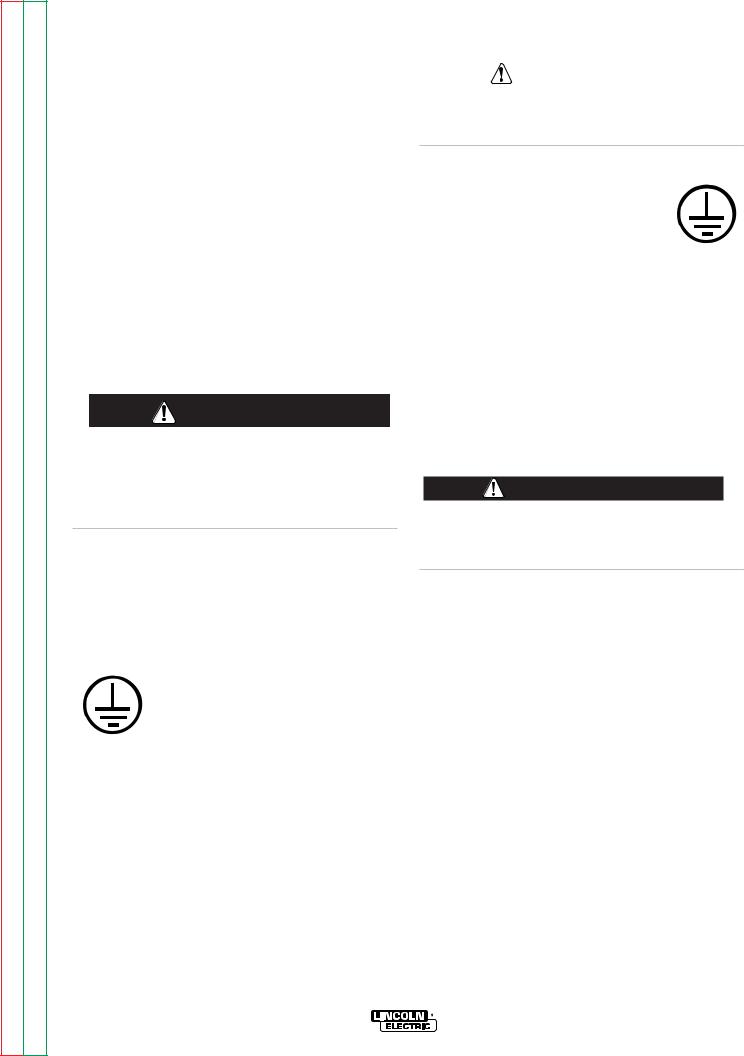
Return to Section TOC |
Return to Master TOC |
Return to Section TOC |
Return to Master TOC |
Return to Section TOC |
Return to Master TOC |
Return to Section TOC |
Return to Master TOC |
A-7 |
|
INSTALLATION |
A-7 |
||
|
|
|
|
|
|
Cable Installation |
|
|
|
|
|
|
|
WARNING |
|
||
|
|
|
|
|
|
Install the welding cables to your POWER-ARC 4000 as follows. See Figure A.1 for the location of parts.
1.The gasoline engine must be OFF to install welding cables.
2.Remove the 1/2 - 13 flanged nuts from the output terminals.
3.Connect the electrode holder and work cables to the weld output terminals. You can connect either cable to either terminal, since the POWERARC 4000 provides AC weld current.
4.Tighten the flanged nuts securely.
5.Be certain that the metal piece you are welding (the “work”) is securely connected to the work clamp and cable.
6.Check and tighten the connections periodically.
CAUTION
•Loose connections will cause the output terminals to overheat. The terminals may eventually melt.
•Do not cross the welding cables at the output terminal connection. Keep the cables isolated and separate from one another.
Lincoln Electric offers a welding accessory kit with the properly specified welding cables. See the ACCESSORIES section of this manual for more information.
MACHINE GROUNDING
Because the POWER-ARC 4000 creates its own power from its gasoline-engine driven generator, you do not need to connect the machine frame to an earth
ground. However, for best protection against electrical shock, connect a heavy gauge wire from the ground stud located on the bottom center of the output panel (see Figure A.1) to a suitable earth ground such as a metal pipe driven into the ground.
Do not ground the machine to a pipe that carries explosive or combustible material.
When the POWER-ARC 4000 is mounted on a truck or a trailer, the machine generator ground stud MUST be securely connected to the metal frame of the vehicle. See Figure A.1. The ground stud is marked with the symbol.
PLUGS AND HAND-HELD EQUIPMENT
For further protection against electric shock, any electrical equipment connected to the generator receptacles must use a three-blade, grounded type plug or an Underwriter’s Laboratories (UL) approved double insulation system with a two-blade plug. Lincoln offers an accessory plug kit that has the right type of plugs. See the ACCESSORIES section of this manual for details.
WARNING
Never operate this machine with damaged or defective cords. All electrical equiptment must be in safe condition.
AUXILIARY POWER RECEPTACLES
The control panel of the POWER-ARC 4000 features two auxiliary power receptacles:
•A 20 amp, 120 volt duplex (double outlet) receptacle
•A 20 amp 240 volt simplex (single outlet) receptacle.
See Figure A.1.
Through these receptacles the machine can supply up to 4,000 rated continuous watts and 4,400 surge watts of single-phase AC power.
POWER-ARC 4000

Return to Section TOC |
Return to Master TOC |
Return to Section TOC |
Return to Master TOC |
Return to Section TOC |
Return to Master TOC |
Return to Section TOC |
Return to Master TOC |
A-8 |
INSTALLATION |
A-8 |
|
|
|
PREMISES WIRING
The POWER-ARC 4000 three-wire, grounded neutral generator allows it to be connected to premises wiring. However, the wiring procedure needed to meet the National Electric Code (NEC) regulations as well as city ordinances can be confusing. The connections could vary from a “commonly grounded” to a “separately derived” system depending on whether you want the unit to be “hardwired” to the premises or only connected temporarily.
WARNING
Only a licensed, certified, trained electrician should install the machine to a premises or residential electrical system. Be certain that:
•The premises is isolated and no feedbacking into the utility system can occur. Certain state and local laws require the premises to be isolated before the generator is linked to the premises. Check your state and local requirements.
•A double pole, double throw transfer switch in conjunction with the properly rated double throw circuit breaker is connected between the generator power and the utility meter.
The POWER-ARC 4000 does not have a combined 120/240 volt twist-lock receptacle and cannot be connected to a premises as described in other Lincoln literature.
Remember that the POWER-ARC 4000 is intended only for backup, intermittent use. The gasoline engine has a rated life of 500 hours. It cannot withstand long-term use without proper maintenance. See the MAINTENANCE section of this manual and the engine owner’s manual for more information.
Certain electrical devices cannot be powered by the POWER-ARC 4000. Refer to Table A.2 for these devices.
CIRCUIT BREAKERS
The POWER-ARC 4000 has its own 20 amp circuit breakers for overload protection. When the machine is
operated in high temperature environments, the breakers may tend to trip at lower loads than normally.
CAUTION
Never bypass the circuit breakers. Without overload protection, the power-arc 4000 could overheat and/or cause damage to the equipment being used.
POWER-ARC 4000

Return to Section TOC |
Return to Master TOC |
Return to Section TOC |
Return to Master TOC |
Return to Section TOC |
Return to Master TOC |
Return to Section TOC |
Return to Master TOC |
A-9 |
INSTALLATION |
A-9 |
|
|
|
CAUTION
Certain Electrical devices cannot be powered by the POWER-ARC 4000. See Table A.2.
TABLE A.2
ELECTRICAL DEVICE USE WITH THE POWER-ARC 4000.
Type |
Common Electrical Devices |
Possible Concerns |
|
|
|
Resistive |
Heaters, toasters, incandescent |
NONE |
|
light bulbs, electric range, hot |
|
|
pan, skillet, coffee maker. |
|
|
|
|
Capacitive |
TV sets, radios, microwaves, |
Voltage spikes or high voltage |
|
appliances with electrical control. |
regulation can cause the capaci- |
|
|
tative elements to fail. Surge |
|
|
protection, transient protection, |
|
|
and additional loading is recom- |
|
|
mended for 100% fail-safe |
|
|
operation. DO NOT RUN |
|
|
THESE DEVICES WITHOUT |
|
|
ADDITIONAL RESISTIVE TYPE |
|
|
LOADS. |
|
|
|
Inductive |
Single-phase induction motors, |
These devices require large |
|
drills, well pumps, grinders, small |
current inrush for starting. (See |
|
refrigerators, weed and hedge |
Table B.3, GENERATOR POWER |
|
trimmers |
APPLICATIONS, in the OPERA- |
|
|
TION section of this manual for |
|
|
required starting wattages.) |
|
|
Some synchronous motors may |
|
|
be frequency sensitive to attain |
|
|
maximum output torque, but |
|
|
they SHOULD BE SAFE from |
|
|
any frequency induced failures. |
|
|
|
Capacitive/Inductive |
Computers, high resolution TV sets, |
An inductive type line condition- |
|
complicated electrical equipment. |
er along with transient and |
|
|
surge protection is required, and |
|
|
liabilities still exist. DO NOT |
|
|
USE THESE DEVICES WITH A |
|
|
POWER-ARC 4000. |
|
|
|
The Lincoln Electric Company is not responsible for any damage to electrical components improperly connected to the POWER-ARC 4000.
POWER-ARC 4000

A-10 |
NOTES |
A-10 |
|
|
|
Return to Section TOC |
Return to Master TOC |
Return to Section TOC |
Return to Master TOC |
Return to Section TOC |
Return to Master TOC |
Return to Section TOC |
Return to Master TOC |
POWER-ARC 4000

Return to Master TOC
Return to Master TOC
Return to Master TOC
Return to Master TOC
Section B |
Section B |
TABLE OF CONTENTS - OPERATION SECTION -
Operation............................................................................................................................... |
Section B |
Safety Instructions ...................................................................................................................... |
B-2 |
General Description .................................................................................................................... |
B-2 |
Recommended Applications....................................................................................................... |
B-3 |
Generator ............................................................................................................................. |
B-3 |
Welder ................................................................................................................................. |
B-3 |
Operational Features and Controls............................................................................................. |
B-3 |
Design Features and Advantages............................................................................................... |
B-3 |
Welding Capability ...................................................................................................................... |
B-3 |
Limitations ................................................................................................................................. |
B-3 |
Controls and Settings ................................................................................................................. |
B-4 |
Generator/Welder Controls .................................................................................................. |
B-4 |
Gasoline Engine Controls..................................................................................................... |
B-5 |
Engine Operation ........................................................................................................................ |
B-6 |
Before Starting the Engine ................................................................................................... |
B-6 |
Starting the Engine ............................................................................................................... |
B-6 |
Stopping the Engine............................................................................................................. |
B-7 |
Break-In Period .................................................................................................................... |
B-7 |
Generator Operation ................................................................................................................... |
B-8 |
General Information.............................................................................................................. |
B-8 |
To Use the Generator as an Auxiliary Power Supply ........................................................... |
B-8 |
Welding Operation .................................................................................................................... |
B-10 |
General Information............................................................................................................ |
B-10 |
Control Function/Operation................................................................................................ |
B-10 |
Welding Guidelines ................................................................................................................... |
B-11 |
Semi-Automatic, Mig Welding With a Weld Pak 100 or Weld Pak 125 .................................... |
B-11 |
Stick Welding ............................................................................................................................ |
B-11 |
POWER-ARC 4000

Return to Section TOC |
Return to Master TOC |
Return to Section TOC |
Return to Master TOC |
Return to Section TOC |
Return to Master TOC |
Return to Section TOC |
Return to Master TOC |
B-2 |
|
OPERATION |
B-2 |
||
|
|
|
|
|
|
OPERATING INSTRUCTIONS |
|
|
|
||
|
|
WARNING |
|
||
Read and understand this entire section before operating your POWER-ARC 4000.
SAFETY INSTRUCTIONS
WARNING
ARC RAYS can burn.
• Wear eye, ear, and body protection.
Do not attempt to use this equipment until you have |
|
|
ENGINE EXHAUST can kill. |
|||
thoroughly read all the operation and maintenance |
|
|
||||
|
|
|
|
|||
manuals supplied with your machine. They include |
|
|
• Use in open, well ventilated areas or |
|||
important safety precautions; detailed engine starting, |
|
|
vent exhaust to the outside. |
|||
operating, and maintenance instructions; and parts |
|
|
• Do not stack anything on or near the |
|||
lists. |
|
|
||||
|
|
engine. |
||||
|
|
|
|
|
||
|
|
|
|
|
|
|
ELECTRIC SHOCK can kill.
•Do not touch electrically live parts or electrodes with your skin or wet clothing.
•Insulate yourself from the work and ground.
•Always wear dry insulating gloves.
FUMES AND GASES can be dangerous.
•Keep your head out of fumes.
•Use ventilation or exhaust to remove fumes from breathing zone.
WELDING SPARKS can cause fire or explosion.
•Keep flammable material away.
•Do not weld on containers that have held combustibles.
MOVING PARTS can injure.
•Do not operate this equipment with any of its doors open or guards off.
•Stop the engine before servicing it.
•Keep away from moving parts.
Only qualified personnel should install, use, or service this equipment.
GENERAL DESCRIPTION
The POWER-ARC 4000 is a generator/ welder designed for home use and other non-commercial applications. As a generator it can supply up to 4,000 continuous watts (or 4,400 surge watts) of 120/240 volt, single-phase AC power. As a welder it provides 125 amps of AC constant current for welding with AC stick electrodes. A single dial provides continuous adjustment of welding output. The machine is lightweight, portable, and can be lifted by two people.
A Briggs & Stratton 8 HP Kool-Bore® Plus air-cooled, gasoline engine powers the generator/welder. The engine has an operating life of approximately 500 hours.
POWER-ARC 4000

Return to Section TOC |
Return to Master TOC |
Return to Section TOC |
Return to Master TOC |
Return to Section TOC |
Return to Master TOC |
Return to Section TOC |
Return to Master TOC |
B-3 |
OPERATION |
B-3 |
|
|
|
The Lincoln warranty covers the Power Arc 4000 (excluding the engine) for 1 year from the date of purchase. The engine is covered by the Briggs & Stratton warranty policy for a period of 1 year for consumer use or 90 days for commercial use.
•Separate ground stud for safe connection of case to earth ground. Single 20 amp, 240 volt generator receptacle.
•Duplex 20 amp, 120 volt generator receptacle.
•Integrated generator output overload protection through two 20 amp circuit breakers.
RECOMMENDED APPLICATIONS
GENERATOR
The POWER-ARC 4000 gives AC generator output for medium use, non-commercial demands. For more details on operating the generator, see GENERATOR OPERATION in the OPERATION section of this manual.
WELDER
The POWER-ARC 4000 provides excellent constant current AC welding output for stick (SMAW) welding. For more details on using the machine as a welder, see WELDING OPERATION in the OPERATION section of this manual.
•Welded-tube, full roll cage frame protects engine and generator/welder.
•Lightweight, portable design.
•Rubber mounting isolates engine and generator from frame to prevent machine “walking” during use.
•Lo-Tone® engine muffler for quieter operation. (A Super Lo-Tone® muffler is available from Briggs & Stratton.)
•Easy-starting, No Maintenance, Electronic Magnetron® ignition.
•Optional Oil Gard® low oil level engine shutdown kit is available from Briggs & Stratton.
OPERATIONAL FEATURES AND CONTROLS
The POWER-ARC 4000 was designed for simplicity. Therefore, it has very few operating controls. A single dial on the control panel lets you select either generator or welding use. For welding, the same dial selects continuous current output over the machine’s 70 to 125 amp range.
The 8 HP Briggs & Stratton gasoline engine controls include a recoil starter, choke, and rotary stop switch. See ENGINE OPERATION in the OPERATION section of this manual for details about starting, running, stopping, and breaking in the gasoline engine.
DESIGN FEATURES AND
ADVANTAGES
•Stick welding (SMAW) process capability with output range from 70 - 125 amps.
•Single-dial current output selection.
•Work and Electrode welding cable mounting terminals.
WELDING CAPABILITY
The POWER-ARC 4000 is rated 125 amps, 20 volts at 30% duty cycle on a ten-minute basis. This means that you can load the welder to 125 amps for three minutes out of every ten-minute period. The machine is also capable of higher duty cycles at lower output currents. You can load the welder to 100 amps for six minutes out of ten for a 60% duty cycle.
The current is continuously variable from 70 to 125 amps AC. The POWER-ARC 4000 can weld with all 3/32 and most 1/8 inch diameter Lincoln AC electrodes.
LIMITATIONS
•The POWER-ARC 4000 is not recommended for any processes besides those that are normally performed using stick welding (SMAW) procedures.
•The POWER-ARC 4000 is not recommended for pipe thawing.
•During welding, generator power is limited to 100 watts, and output voltages can drop from 120 to 80 volts and 240 to 160 volts. Therefore, DO NOT OPERATE ANY SENSITIVE ELECTRICAL EQUIPMENT WHILE YOU ARE WELDING.
POWER-ARC 4000
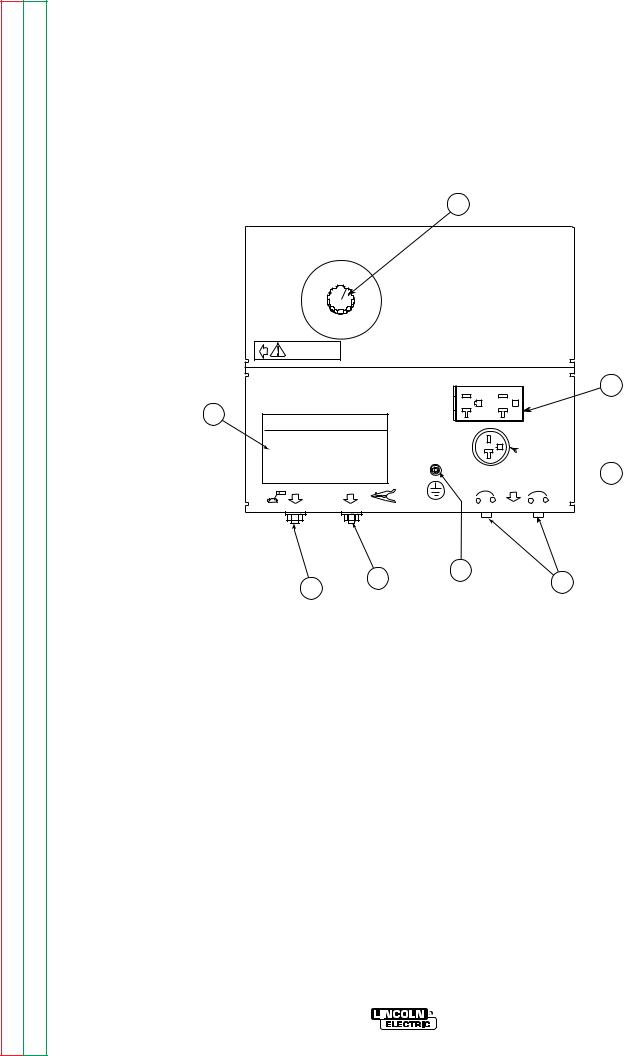
Return to Section TOC |
Return to Master TOC |
Return to Section TOC |
Return to Master TOC |
Return to Section TOC |
Return to Master TOC |
Return to Section TOC |
Return to Master TOC |
B-4 |
OPERATION |
B-4 |
|
|
|
CONTROLS AND SETTINGS
All generator/welder controls are located on the Output Control Panel. Gasoline engine controls are mounted on the engine. See Figures B.1 and B.2 and the explanations that follow.
FIGURE B.1 – OUTPUT PANEL CONTROLS
1
POWER ARC 4000
70 |
80 |
AMPS |
|
AMPS |
|
125 |
90 |
AMPS |
|
GENERATOR |
AMPS |
100
AMPS
WARNING
8
2
ELECTRODE SELECTION GUIDE
 7
7
|
4 |
5 |
3 |
6 |
|
|
|
1.CURRENT CONTROL DIAL
2.ELECTRODE SELECTION GUIDE
3.WELD OUTPUT TERMINAL (TO ELECTRODE HOLDER) WITH 1/2 - 13 FLANGE NUT
4.WELD OUTPUT TERMINAL (TO WORK) WITH 1/2 - 13 FLANGE NUT
5.GROUND STUD
6.20 AMP CIRCUIT BREAKERS (2)
7.20 AMP, 240 VOLT RECEPTACLE
8.20 AMP, 120 VOLT DUPLEX RECEPTACLE
GENERATOR/WELDER CONTROLS
See Figure B.1 for the location of the following features:
1.CURRENT CONTROL DIAL: Adjusts continuous current output. The amperages on the dial correspond to the average amperages needed for specific Lincoln welder rods.
2.ELECTRODE SELECTION GUIDE: Provides recommended electrode type, size, and welder output setting based on the thickness of the work.
3.WELD OUTPUT TERMINAL (TO ELECTRODE HOLDER) WITH 1/2 - 13 FLANGE NUT: Provides the connection point for either the electrode holder or the work cable. (Because the POWERARC 4000 is an AC output machine, either output terminal can be used for either cable.)
4.WELD OUTPUT TERMINAL (TO WORK) WITH 1/2 - 13 FLANGE NUT: Provides the connection point for either the electrode holder or the work cable. (Because the POWER-ARC 4000 is an AC output machine, either output terminal can be used for either cable.)
POWER-ARC 4000
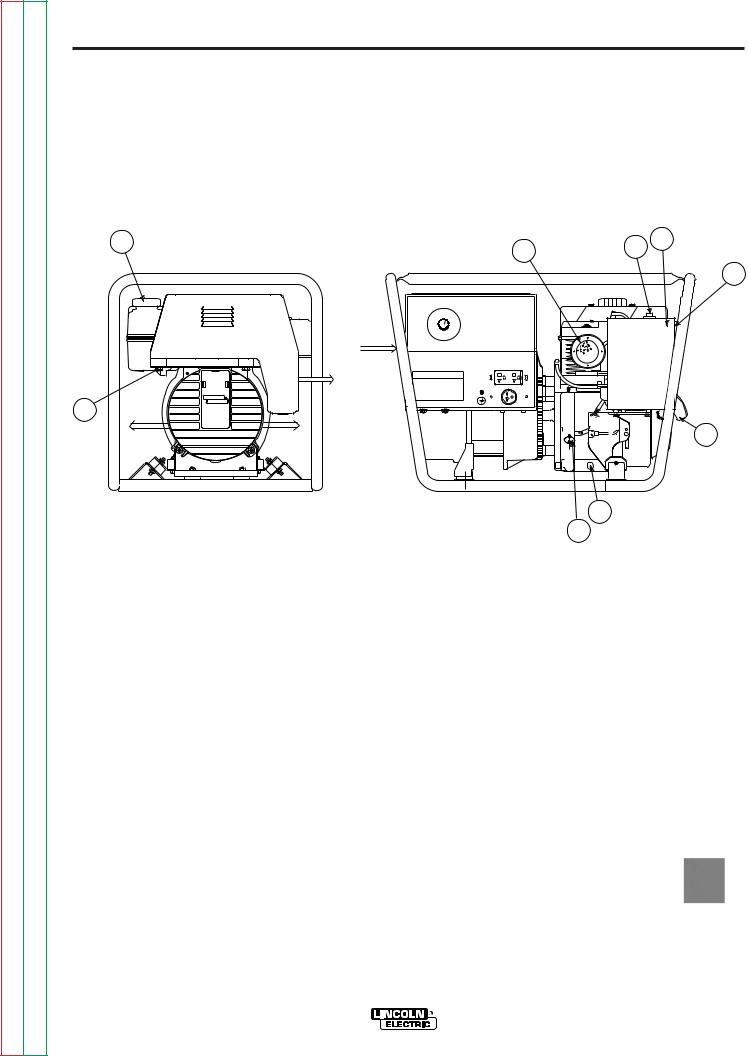
Return to Section TOC |
Return to Master TOC |
Return to Section TOC |
Return to Master TOC |
Return to Section TOC |
Return to Master TOC |
Return to Section TOC |
Return to Master TOC |
B-5 |
OPERATION |
|
B-5 |
|||
5. GROUND STUD: Provides a connection point for |
7. |
20 AMP, 240 VOLT RECEPTACLE: Connection |
||||
|
connecting the machine case to earth ground for |
|
point for supplying 240 volt power to operate one |
|||
|
the safest grounding procedure. |
|
electrical device. |
|
|
|
6. 20 AMP CIRCUIT BREAKERS (2): Provide sepa- |
8. |
20 AMP, 120 VOLT DUPLEX RECEPTACLE: |
||||
|
rate overload current protection for the 120 volt |
|
Connection point for supplying 120 volt power to |
|||
|
and 240 volt receptacles. |
|
|
operate one or two electrical devices. |
||
|
|
FIGURE B.2 – GASOLINE ENGINE CONTROLS |
|
|
||
|
2 |
|
|
3 |
4 |
5 |
|
|
|
|
|
|
6 |
|
|
|
|
POWER ARC 4000 |
|
|
|
|
|
70 |
80 |
|
|
|
|
|
MIN. |
|
|
|
|
|
|
MAX. |
90 |
|
|
|
|
|
|
100 |
|
|
|
|
AIR |
|
|
|
|
|
|
IN |
|
|
|
|
|
|
ENGINE |
ELECTRODE SELECTION GUIDE |
|
|
|
|
|
EXHAUST |
|
|
|
|
1 |
LINCOLN |
|
|
|
|
|
ELECTRIC |
|
|
|
|
|
|
AIR |
AIR |
|
|
|
|
|
|
|
|
|
7 |
||
|
OUT |
OUT |
|
|
|
|
|
|
|
|
|
||
8
9
1. |
FUEL SHUTOFF VALVE |
6. |
CHOKE |
2. |
FUEL TANK AND CAP |
7. |
RECOIL STARTER |
3. |
MUFFLER |
8. |
OIL DRAIN PLUG |
4. |
ROTARY STOP SWITCH |
9. |
OIL FILL PLUG |
5. |
AIR CLEANER |
|
|
GASOLINE ENGINE CONTROLS
See Figure B.2 for the location of the following features:
1.FUEL SHUTOFF VALVE: Stops the flow of gasoline from the fuel tank to the carburetor. Should be closed whenever you are finished using the POWER-ARC 4000. Must be opened before you start the engine.
2.FUEL TANK AND CAP: Holds 1.0 gallon (3.8 liters) of unleaded gasoline. Contains a 50 micron fuel filter molded at the outlet port.
NOTE: If you use any other alternate fuel tank or supply, be sure to use a recommended inline fuel filter.
3.MUFFLER: Reduces engine noise output. Does not serve as a spark arrester. See SPARK ARRESTER in the INSTALLATION section of this manual.
4.ROTARY STOP SWITCH: Stops the engine by grounding the ignition circuit.
5.AIR CLEANER: Filters intake air to the carburetor. See ENGINE MAINTENANCE in the MAINTENANCE section of this manual for details about the specific type of air cleaner to use.
6.CHOKE: Provides a richer air/fuel mixture for cold engine starting conditions. See the topic ENGINE OPERATION, below, for details on setting the choke.
POWER-ARC 4000

Return to Section TOC |
Return to Master TOC |
Return to Section TOC |
Return to Master TOC |
Return to Section TOC |
Return to Master TOC |
Return to Section TOC |
Return to Master TOC |
B-6 |
OPERATION |
B-6 |
|
|
|
7.RECOIL STARTER: Manual, rope-type starter. The handle position allows easy starting from either ground level or pickup-truck level.
8.OIL DRAIN PLUG: Permits convenient draining of engine oil during maintenance. Both sides of the engine are equipped with an oil drain plug.
9.OIL FILL PLUG: Permits convenient filling of engine oil during maintenance. Both sides of the engine are equipped with an oil fill plug.
ENGINE OPERATION
WARNING
DO NOT RUN THE ENGINE AT EXCESSIVE SPEEDS. The maximum allowable high idle speed for the POWER-ARC 4000 is 3750 RPM, no load. Do NOT adjust the governor screw on the engine. Severe personal injury and damage to the machine can result if it is operated at speeds above the maximum rated speed.
Read and understand all safety instructions included in the Briggs & Stratton Operating and Maintenance Instructions manual that is shipped with the POWER-ARC 4000.
BEFORE STARTING THE ENGINE
CHECK AND FILL THE ENGINE OIL LEVEL:
1. Place the machine on a level surface.
2.Open the oil fill plug.
3.Fill (if necessary) until oil flows out the top of the fill plug hole.
4.Replace the fill plug and tighten securely.
CHECK AND FILL THE ENGINE FUEL TANK:
1.Remove the fuel tank cap.
2.Fill the tank to allow approximately 1/4 inch (5 mm) of tank space for fuel expansion. DO NOT FILL THE TANK TO THE POINT OF OVERFLOW.
3.Replace the fuel tank cap and tighten securely.
NOTE: The engine will operate satisfactorily on any gasoline meant for automotive use. A minimum of 87 octane is recommended. DO NOT MIX OIL WITH THE GASOLINE.
Use clean, fresh, lead-free gasoline. Leaded gasoline may be used if lead-free is not available. However, lead-free gasoline leaves fewer combustion deposits and gives longer valve life. For engine protection from fuel deposits, use Briggs & Stratton Gasoline Additive, part number 5041. Purchase gasoline in quantities that will be used within 30 days, to assure freshness.
NOTE: We DO NOT recommend using gasoline that contains alcohol, such as gasohol. However, if gasoline with alcohol is used, it MUST NOT contain more than 10% Ethanol and MUST be removed from the engine during storage. DO NOT use gasoline containing Methanol.
STARTING THE ENGINE
NOTE: Remove all loads connected to the AC power receptacles before starting the gasoline engine. Turn the Rotary Stop Switch to the “ON” position.
FOR A “COLD” ENGINE:
1.Open the fuel shutoff valve on the bottom of the fuel tank.
2.Place the choke lever in the “CHOKE” position.
3.Pull slightly on the recoil starter handle until resistance is felt.
POWER-ARC 4000
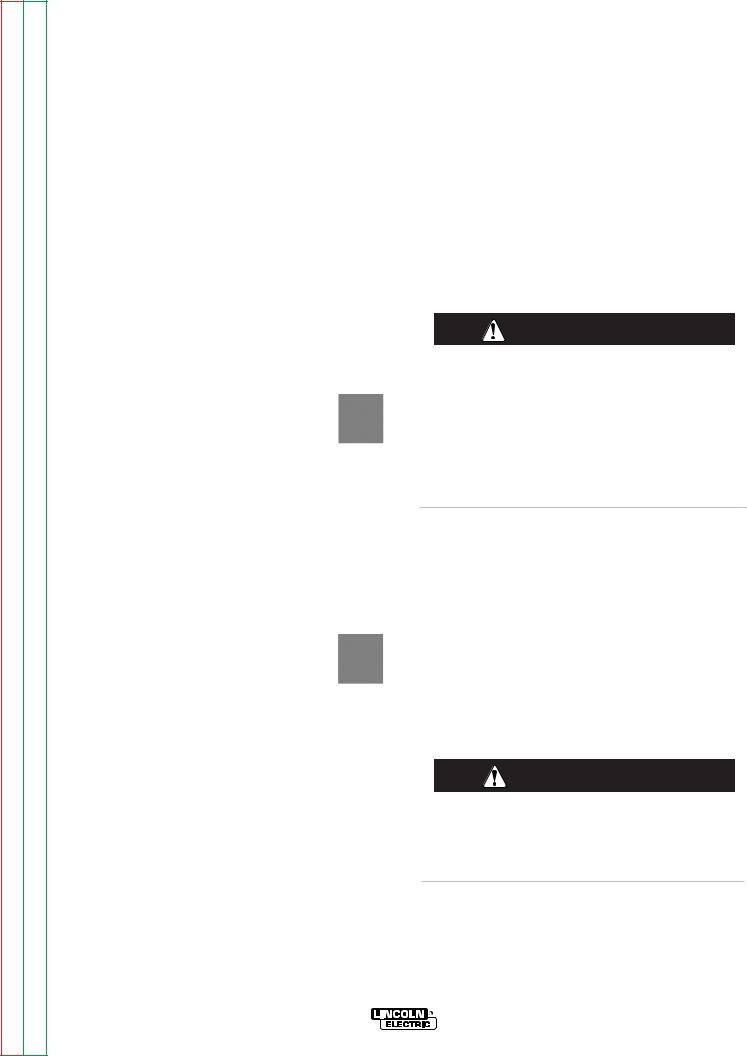
Return to Section TOC |
Return to Master TOC |
Return to Section TOC |
Return to Master TOC |
Return to Section TOC |
Return to Master TOC |
Return to Section TOC |
Return to Master TOC |
B-7 |
OPERATION |
B-7 |
|
|
|
4.Pull the cord rapidly.
5.If the engine does not start, open the choke slightly (move lever upward) and pull the starter cord rapidly again.
When the engine starts, gradually open the choke to the “RUN” position. To open the choke fully, requires an engine warm-up period of several seconds to several minutes depending on the temprature. After starting the engine, first open the choke (toward RUN) until the engine just begins to run smoothly. Then open the choke in small steps, allowing the engine to accept small changes in speed and load, until the choke is fully open (in RUN). During engine warm-up the equiptment can be operated.
FOR A “HOT” ENGINE:
STOPPING THE ENGINE
1.Remove all welding and generator power loads and let the engine cool by running it for several minutes.
2.Stop the engine by turning the Rotary Stop Switch on top of the engine to the “OFF” position.
3.Hold the lever down firmly until the engine completely stops. Otherwise, the engine may restart or sputter as it stops.
4.Close the fuel shutoff valve at the bottom of the fuel tank.
WARNING
1.Open the fuel shutoff valve on the bottom of the fuel tank.
2.Place the choke lever in the highest, upward position. Closing the choke of a hot engine will flood the carburetor and prevent starting.
3.Pull slightly on the recoil starter handle until resistance is felt.
4.Pull the cord rapidly.
FOR BEST ENGINE STARTING:
•Always use fresh gasoline and be sure the filter is clean and properly maintained.
•If you use an alternate fuel tank or supply, be sure to install an in-line fuel filter.
•Do not pull the recoil starter with the choke in the downward position more than one time. Repeated pulls on a choked engine will flood the carburetor.
•If the engine will not start, see the TROUBLESHOOTING section of this manual.
Close the fuel valve when the machine is transported to prevent fuel leakage from the carburetor. Drain the tank before transporting the machine in a vehicle.
For long periods of storage, turn off the fuel shutoff valve (lowest, downward position) and let the engine run until there is no more fuel in the line. Use a fuel additive such as Sta-Bil to minimize fuel gum deposits.
RUNNING THE ENGINE
The engine is set at the factory to run at high idle speed when not under load. You should not adjust this setting yourself.
BREAK-IN PERIOD
The engine will use a greater amount of oil during its “break-in” period. The break-in is about 12 running hours.
Check the oil frequently during break-in. Change the oil after the first 5 hours of operation. For more details, see the MAINTENANCE section of the engine owner’s manual.
CAUTION
During break-in, subject the POWER-ARC 4000 to only moderate loads. Avoid long periods running at idle. Before stopping the engine, remove all loads and allow the engine to cool several minutes.
POWER-ARC 4000

Return to Section TOC |
Return to Master TOC |
Return to Section TOC |
Return to Master TOC |
Return to Section TOC |
Return to Master TOC |
Return to Section TOC |
Return to Master TOC |
B-8 |
OPERATION |
B-8 |
|
|
|
GENERATOR OPERATION
CAUTION
Be sure that any electrical equipment plugged into the generator’s AC power receptacles can withstand a ±10% voltage and a ±5% frequency variation. Some electronic devices cannot be powered by the POWER-ARC 4000. Refer to Table A.2,
ELECTRICAL DEVICE USE WITH THE POWERARC 4000, in the INSTALLATION section of this manual.
GENERAL INFORMATION
The POWER-ARC 4000 generator is rated at 4000 continuous watts (4400 surge watts). It provides both 120 volt and 240 volt power. You can draw up to 20 amps from either side of the 120 volt duplex receptacle, but no more than 37 amps from both sides at once. Up to 18 amps can be drawn from the single 240 volt receptacle.
Electrical loads in watts are calculated by multiplying the voltage rating of the load by the number of amps it draws. (This information is given on the load device nameplate.) For example, a device rated 115 volts, 2 amps will need 230 watts of power (115 x 2 = 230).
You can use Table B.3, GENERATOR POWER APPLICATIONS, to determine the wattage requirements of the most common types of loads you can power with the POWER-ARC 4000. Be sure to read the notes at the bottom of the table.
TO USE THE GENERATOR AS AN
AUXILIARY POWER SUPPLY:
1.Start the gasoline engine. See ENGINE OPERATION in this section of the manual.
2.Set the current control dial on the output control panel to “GENERATOR.” See Figure B.1.
3.Plug the load(s) into the appropriate 120 volt or 240 volt power receptacle.
NOTE: During welding, the maximum generator output for auxiliary loads is 100 watts.
NOTE: You can supply multiple loads as long as the total load does not exceed 4,000 watts. Be sure to start the largest loads first.
POWER-ARC 4000

Return to Section TOC |
Return to Master TOC |
Return to Section TOC |
Return to Master TOC |
Return to Section TOC |
Return to Master TOC |
Return to Section TOC |
Return to Master TOC |
B-9 |
OPERATION |
B-9 |
|
|
|
TABLE B.1
GENERATOR POWER APPLICATIONS
|
Suggested Power Applications |
Running Watts |
*Start-up Watts |
|
|
*Air Compressor - 3/4 HP |
1,250 |
3,100 - 5,000 |
|
|
*Airless Sprayer - 1/3 HP |
600 |
1,500 - 2,400 |
|
|
Chain Saw |
1,200 |
|
|
|
Circular Saw |
1,200 |
|
|
|
Coffee Maker |
1,000 |
|
|
|
*Deep Freezer |
500 |
750 - 2,000 |
|
|
*Electric Motor - 1 HP |
1,000 |
2,500 - 4,000 |
|
|
Electric Range (1 element) |
1,500 |
|
|
|
Electric Skillet |
1,250 |
|
|
|
*Furnace Fan - 1/3 HP |
1,200 |
3,000 - 4,800 |
|
|
Portable Grinder (4 1/2”) |
600 |
|
|
|
Portable Grinder (7”) |
2,000 |
|
|
|
Halogen Work Light |
500 |
|
|
|
Hand Drill - 1/4” |
500 |
|
|
|
Hand Drill - 3/8” |
700 |
|
|
|
1500 Watt Heater |
1,750 |
|
|
|
Hedge Trimmer |
450 |
|
|
|
Light Bulb |
100 |
|
|
|
Reciprocating Saw |
900 |
|
|
|
Radial Arm Saw |
2,600 |
|
|
|
Radio |
50 |
|
|
|
*Refrigerator/Freezer (small) |
600 |
1,500 - 2,400 |
|
|
Slow Cooker |
200 |
|
|
|
*Submersible Pump - 1 HP |
1,000 |
2,500 - 4,000 |
|
|
*Sump Pump |
600 |
1,500 - 2,400 |
|
|
Toaster |
1,100 |
|
|
|
Weed Trimmer |
500 |
|
|
|
Lincoln 100 or 125 Amp Wire Feeder/Welder |
4,000 |
|
|
|
|
|
|
|
NOTES:
Wattages listed are approximate. Check your equipment for actual wattage.
Equipment with unusually high *START-UP WATTS are listed. For start-up of other equipment listed in the table, multiply RUNNING WATTS by 2.
Multiple loads can be used as long as the total load does not exceed 4,000 watts. Be sure to start the largest loads first. For example, a 1 HP motor needs approximately 1,000 watts while running but may require 2,500 watts to start. Some inductive motors may require as much as 4 times running watts to start.
POWER-ARC 4000

Return to Section TOC |
Return to Master TOC |
Return to Section TOC |
Return to Master TOC |
Return to Section TOC |
Return to Master TOC |
Return to Section TOC |
Return to Master TOC |
B-10 |
|
OPERATION |
B-10 |
|
|
|
|
WELDING OPERATION |
3. Attach the work clamp securely to the work you |
||
|
|
are welding. |
|
GENERAL INFORMATION
WARNING
Do not touch electrically live parts or electrodes with your skin or wet clothing.
Do not breathe welding fumes or gases.
Use ventilation or exhaust to remove welding fumes from the breathing area.
Keep flammable material away.
Wear eye, ear, and body protection.
The POWER-ARC 4000 generator/welder can deliver from 70 to 125 amps of continuous welding output current . Output can be adjusted by setting the current control dial on the output control panel.
You can get maximum welding output by setting the dial to 125 AMPS. At high current settings like this, some output may decrease as the machine is used. If you are welding for a long time, you may need to turn the dial slightly upward to maintain the same results.
The numbers on the dial correspond to the average amps needed to weld using specific Lincoln welding rods. Table B.2, WELDING APPLICATIONS, gives you the recommended dial settings based on the thickness of the work and the size and type of rod you’re using.
TO USE THE POWER-ARC 4000 FOR WELDING:
1.Remove the flange nuts from the weld output terminals and place the work and electrode welding cables over the terminals. See Figure B.1. Replace and tighten the flange nuts securely. Be sure the connections are tight.
2.Select the appropriate electrode. See Table B.2, WELDING APPLICATIONS, or the ELECTRODE SELECTION GUIDE on the machine Output Control Panel.
4.Insert the electrode into the electrode holder.
5.Set the current control dial to the desired output current.
6.Start the gasoline engine. See ENGINE OPERATION in this section of the manual.
7.Strike an arc and begin welding. For information on welding techniques, see WELDING GUIDELINES in this section of the manual.
AFTER YOU FINISH THE WELD:
1.Stop the gasoline engine. See ENGINE OPERATION in this section of the manual.
2.Allow the electrode and work to cool completely.
3.Remove the work clamp from the work.
4.Remove any remaining piece of electrode from the electrode holder.
5.If you are finished using the POWER-ARC 4000 for welding, disconnect the welding cables from the weld output terminals. Reattach the flange nuts and leave them on the terminals.
NOTE: 1. Welding current is continuously variable with 60% duty cycle applying to output currents 100 Amps and less and 30% duty cycle applying to currents above
100 Amps.
2.Duty cycle is based on a ten minute period. The welder can be loaded to 125 Amps for three minutes out of every ten minute period or to 100 Amps for six minutes out of every ten minute period.
CONTROL FUNCTION / OPERATION “Current Control Dial”
Provides welding current adjustment from 70 through 125 Amps.
To obtain maximum weld output, turn the “Current Control Dial” to “125 Amps” for either a cold or hot engine. As the machine is used, some welding voltage may decrease at high current settings. If you are welding for long periods of time, the dial may need to be slightly turned upward to provide the same welding results as when the machine was cold.
The numbers listed on the dial correspond to the average amperage needed to weld specific Lincoln rods. Refer to Table B.2 “Welding Application Chart” and “Electrode Selection Guide” listed on the machine nameplate for proper current and electrode settings.
POWER-ARC 4000

Return to Section TOC |
Return to Master TOC |
Return to Section TOC |
Return to Master TOC |
Return to Section TOC |
Return to Master TOC |
Return to Section TOC |
Return to Master TOC |
B-11 |
OPERATION |
B-11 |
|
|
|
WELDING GUIDELINES
TABLE B.2
WELDING APPLICATIONS/ELECTRODE SELECTION GUIDE
Material Thickness |
Electrode Type |
Size |
Setting |
|
|
|
|
1/8” and thinner |
FLEETWELD® 37 |
3/32” |
90 amps |
|
1AWS E6013 |
|
|
|
FLEETWELD® 180 |
|
70 amps |
|
AWS E6011 |
|
|
|
Lincoln 7018 AC |
90 amps |
|
|
AWS E7018 |
|
|
|
|
|
|
3/16” Maximum |
FLEETWELD® 37 |
1/8” |
125 amps |
|
AWS E6013 |
|
|
|
|
|
|
5/16” Maximum |
FLEETWELD® 180 |
1/8” |
90 amps |
|
AWS E6011 |
|
|
|
|
|
|
Any Thickness |
WEARSHIELD® ABR |
1/8” |
100 amps |
|
|
|
|
NOTES:
The values listed are suggested settings. Actual setting may vary depending on individual preference and/or specific application. Beginners should use Lincoln E7018 AC.
For electrodes not listed, follow tables that are packed with the electrodes.
Ask for the Lincoln WELD DIRECTORY (Publication M210) for a complete listing of all Lincoln stick electrodes available.
1AWS = American Welding Society
Semi-automatic, MIG Welding With a Lincoln Weld Pak 100 or Weld Pak 125
 WARNING
WARNING
ARC RAYS can burn.
• When using an open arc process, it is necessary to use correct eye, head and body protection.
Stick Welding
Stick welding is probably the most familiar welding process known. A coated ELECTRODE, the weld rod, is clamped into an ELECTRODE HOLDER, an insulated clamping device, which in turn connects to the ELECTRODE CABLE, a heavy wire. The WORK, the metal piece to be welded, is connected to the WORK CABLE, a heavy wire which contains the WORK CLAMP. Quality Lincoln cables use many fine copper wires with a very flexible insulating covering for the electrode and work cables. When properly connected to the OUTPUT STUDS of a high current power source, the electrode melts and bonds the metal being repaired. See “Cable Installation” section for proper cable connection to a Power-Arc.
The Power-Arc provides excellent weld output characteristics when used in combination with Lincoln AC electrodes. Other AC electrodes may also be used.
Follow the settings listed in Table B.2 “Welding Application Chart” and the “Electrode Selection Guide” found on the nameplate of the machine.
The Power-Arc generator power can be used to supply power to a Lincoln Weld-Pak 100 or Weld-Pak 125 wire feed welder. The Weld-Pak is equipped with all the supplies needed for Flux-Cored Arc Welding (FCAW), and is available where Lincoln products are sold.
A K610-1 MIG Conversion Kit is also available for the Weld-Pak which provides all the essentials needed for Gas Metal Arc Welding, GMAW, or MIG processes. Contact your local authorized Lincoln representative for more details.
Learning To Stick Weld
The serviceability of a product or structure utilizing this type of information is and must be the sole responsibility of the builder/user. Many variables beyond the control of The Lincoln Electric Company affect the results obtained in applying this type of information. These variables include, but are not limited to, welding procedure, plate chemistry and temperature, weldment design, fabrication methods and service requirements.
POWER-ARC 4000

Return to Section TOC |
Return to Master TOC |
Return to Section TOC |
Return to Master TOC |
Return to Section TOC |
Return to Master TOC |
Return to Section TOC |
Return to Master TOC |
B-12 |
OPERATION |
B-12 |
|
|
|
Semi-automatic, MIG Welding With a Lincoln Weld Pak 100 or Weld Pak 125
 WARNING
WARNING
ARC RAYS can burn.
• When using an open arc process, it is necessary to use correct eye, head and body protection.
The Power-Arc generator power can be used to supply power to a Lincoln Weld-Pak 100 or Weld-Pak 125 wire feed welder. The Weld-Pak is equipped with all the supplies needed for Flux-Cored Arc Welding (FCAW), and is available where Lincoln products are sold.
A K610-1 MIG Conversion Kit is also available for the Weld-Pak which provides all the essentials needed for Gas Metal Arc Welding, GMAW, or MIG processes. Contact your local authorized Lincoln representative for more details.
Stick Welding
Stick welding is probably the most familiar welding process known. A coated ELECTRODE, the weld rod, is clamped into an ELECTRODE HOLDER, an insulated clamping device, which in turn connects to the ELECTRODE CABLE, a heavy wire. The WORK, the metal piece to be welded, is connected to the WORK CABLE, a heavy wire which contains the WORK CLAMP. Quality Lincoln cables use many fine copper wires with a very flexible insulating covering for the electrode and work cables. When properly connected to the OUTPUT STUDS of a high current power source, the electrode melts and bonds the metal being repaired. See “Cable Installation” section for proper cable connection to a Power-Arc.
The Power-Arc provides excellent weld output characteristics when used in combination with Lincoln AC electrodes. Other AC electrodes may also be used.
Follow the settings listed in Table B.2 “Welding Application Chart” and the “Electrode Selection Guide” found on the nameplate of the machine.
Learning To Stick Weld
The serviceability of a product or structure utilizing this type of information is and must be the sole responsibility of the builder/user. Many variables beyond the control of The Lincoln Electric Company affect the results obtained in applying this type of information. These variables include, but are not limited to, welding procedure, plate chemistry and temperature, weldment design, fabrication methods and service requirements.
No one can learn to weld simply by reading about it. Skill comes only with practice. The following pages will help the inexperienced welder understand welding and develop his skill. For more detailed information, order a copy of the book “New Lessons in Arc Welding.” (See Book Division section at rear of manual).
The operator’s knowledge of arc welding must go beyond the arc itself. He must know how to control the arc, and this requires a knowledge of the welding circuit and the equipment that provides the electric current used in the arc. The circuit begins where the electrode cable is attached to the welding machine and ends where the work cable cable is attached to the machine. Current flows through the electrode cable to the electrode holder, through the electrode holder to the electrode and across the arc. On the work side of the arc, the current flows through base metal to the work cable and back to the welding machine. The circuit must be complete for the current to flow. To weld, the work clamp must be tightly connected to clean base metal. Remove paint, rust,etc. as necessary to get a good connection. Connect the work clamp as close as possible to the area you wish to weld. Avoid allowing the welding circuit to pass through hinges, bearings, electronic components or similar devices that can be damaged.
POWER-ARC 4000
